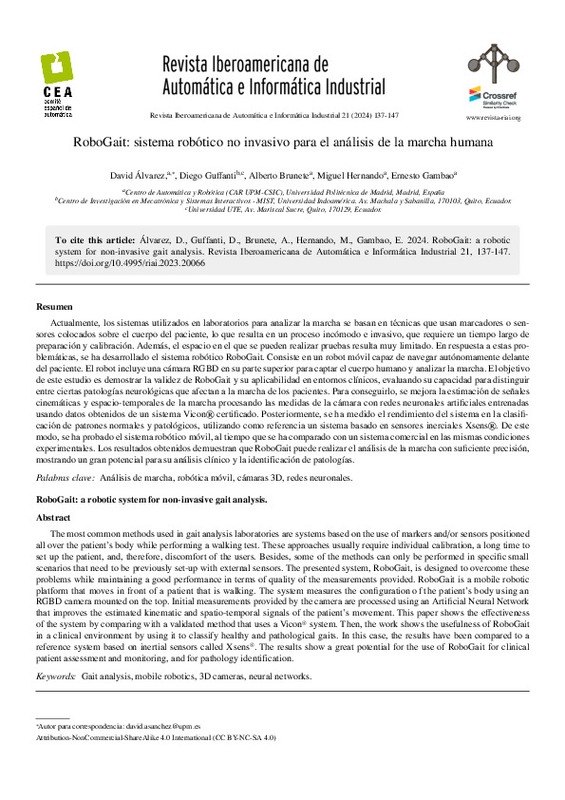JavaScript is disabled for your browser. Some features of this site may not work without it.
Buscar en RiuNet
Listar
Mi cuenta
Estadísticas
Ayuda RiuNet
Admin. UPV
RoboGait: sistema robótico no invasivo para el análisis de la marcha humana
Mostrar el registro sencillo del ítem
Ficheros en el ítem
| dc.contributor.author | Álvarez, David
|
es_ES |
| dc.contributor.author | Guffanti, Diego
|
es_ES |
| dc.contributor.author | Brunete, Alberto
|
es_ES |
| dc.contributor.author | Hernando, Miguel
|
es_ES |
| dc.contributor.author | Gambao, Ernesto
|
es_ES |
| dc.date.accessioned | 2024-04-19T10:17:15Z | |
| dc.date.available | 2024-04-19T10:17:15Z | |
| dc.date.issued | 2023-10-31 | |
| dc.identifier.issn | 1697-7912 | |
| dc.identifier.uri | http://hdl.handle.net/10251/203616 | |
| dc.description.abstract | [EN] The most common methods used in gait analysis laboratories are systems based on the use of markers and/or sensors positioned all over the patient s body while performing a walking test. These approaches usually require individual calibration, a long time to set up the patient, and, therefore, discomfort of the users. Besides, some of the methods can only be performed in specific small scenarios that need to be previously set-up with external sensors. The presented system, RoboGait, is designed to overcome these problems while maintaining a good performance in terms of quality of the measurements provided. RoboGait is a mobile robotic platform that moves in front of a patient that is walking. The system measures the configuration of the patient s body using an RGBD camera mounted on the top. Initial measurements provided by the camera are processed using an Artificial Neural Network that improves the estimated kinematic and spatio-temporal signals of the patient s movement. This paper shows the effectiveness of the system by comparing with a validated method that uses a Vicon® system. Then, the work shows the usefulness of RoboGait in a clinical environment by using it to classify healthy and pathological gaits. In this case, the results have been compared to a reference system based on inertial sensors called Xsens®. The results show a great potential for the use of RoboGait for clinicalpatient assessment and monitoring, and for pathology identification. | es_ES |
| dc.description.abstract | [ES] Actualmente, los sistemas utilizados en laboratorios para analizar la marcha se basan en técnicas marcadores o sensores colocados sobre el cuerpo del paciente, lo que resulta en un proceso que requiere un tiempo largo de preparación y calibración, así como la incomodidad que causa a los pacientes tener dispositivos colocados por el cuerpo. Adem´as, el espacio en el que se pueden realizar pruebas resulta muy limitado. En respuesta a estas problemáticas, se ha desarrollado el sistema robótico RoboGait. Consiste en un robot móvil capaz de navegar autónomamente delante del paciente. El robot incluye una cámara RGBD en su parte superior para captar el cuerpo humano. Este sistema no requiere marcadores adheridos al cuerpo del paciente ya que utiliza la información proporcionada por la cámara RGBD para analizar la marcha. El objetivo de este estudio es demostrar la validez de RoboGait y su aplicabilidad en entornos clínicos. Para conseguirlo, se ha optado por mejorar la estimación de señales cinemáticas y espacio-temporales de la marcha procesando las medidas de la cámara con redes neuronales artificiales (RNA) entrenadas usando datos obtenidos de un sistema Vicon® certificado. Posteriormente, se ha medido el rendimiento del sistema en la clasificación de patrones normales y patológicos, utilizando como referencia un sistema basado en sensores inerciales Xsens®. De este modo, se ha probado el sistema robótico móvil en un rango amplio de la marcha, al tiempo que se ha comparado con un sistema comercial en las mismas condiciones experimentales. Los resultados obtenidos demuestran que RoboGait puede realizar el análisis de la marcha con suficiente precisión,mostrando un gran potencial para su análisis clínico y la identificación de patologías. | es_ES |
| dc.description.sponsorship | Esta investigación ha recibido financiación del Programa Estatal de Generación de Conocimiento y Fortalecimiento Científico y Tecnológico del Sistema de I+D+i y de I+D+i Orientada a los Retos de la Sociedad del Ministerio de Ciencia e Innovación de España, PID2020-118299RB. | es_ES |
| dc.language | Español | es_ES |
| dc.publisher | Universitat Politècnica de València | es_ES |
| dc.relation | info:eu-repo/grantAgreement/AEI/Plan Estatal de Investigación Científica y Técnica y de Innovación 2017-2020/PID2020-118299RB-I00/ES/SISTEMA ROBOTICO NO INVASIVO PARA EL ANALISIS BIOMECANICO DE LA MARCHA HUMANA/ | es_ES |
| dc.relation.ispartof | Revista Iberoamericana de Automática e Informática industrial | es_ES |
| dc.rights | Reconocimiento - No comercial - Compartir igual (by-nc-sa) | es_ES |
| dc.subject | Gait analysis | es_ES |
| dc.subject | Mobile robotics | es_ES |
| dc.subject | 3D cameras | es_ES |
| dc.subject | Neural Networks | es_ES |
| dc.subject | Análisis de marcha | es_ES |
| dc.subject | Robótica móvil | es_ES |
| dc.subject | Cámaras 3D | es_ES |
| dc.subject | Redes neuronales | es_ES |
| dc.title | RoboGait: sistema robótico no invasivo para el análisis de la marcha humana | es_ES |
| dc.title.alternative | RoboGait: a robotic system for non-invasive gait analysis | es_ES |
| dc.type | Artículo | es_ES |
| dc.identifier.doi | 10.4995/riai.2023.20066 | |
| dc.rights.accessRights | Abierto | es_ES |
| dc.description.bibliographicCitation | Álvarez, D.; Guffanti, D.; Brunete, A.; Hernando, M.; Gambao, E. (2023). RoboGait: sistema robótico no invasivo para el análisis de la marcha humana. Revista Iberoamericana de Automática e Informática industrial. 21(2):137-147. https://doi.org/10.4995/riai.2023.20066 | es_ES |
| dc.description.accrualMethod | OJS | es_ES |
| dc.relation.publisherversion | https://doi.org/10.4995/riai.2023.20066 | es_ES |
| dc.description.upvformatpinicio | 137 | es_ES |
| dc.description.upvformatpfin | 147 | es_ES |
| dc.type.version | info:eu-repo/semantics/publishedVersion | es_ES |
| dc.description.volume | 21 | es_ES |
| dc.description.issue | 2 | es_ES |
| dc.identifier.eissn | 1697-7920 | |
| dc.relation.pasarela | OJS\20066 | es_ES |
| dc.contributor.funder | Ministerio de Ciencia e Innovación | es_ES |








